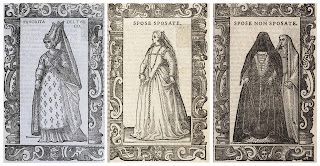The
fashion illustrations were drawn as fashion plates at the beginning, and the fashion plates are published through newspapers and magazines in the old days, so the
development of newspapers and magazines at that time is the barometer of
fashion illustrations. From the 18th century onward newspapers and
magazines becoming the most popular medium to flow through the fashion styles
especially from France and Italy.
In the first part, I will illustrate the most famous publishing in four countries – the France,
the Germany, the England, and the America.
In
France,
magazines the Monument du costume
(1775), Galeries des modes (1777),
and the Cabinet des modes (1785) were
published as the model of fashion periodicals and many of them were translated
and published in other countries. Because of the French Revolution, the fashion
and publishing industry declined bit by bit until Napoleon encouraged the regeneration of
fashion industry
in the mid-nineteenth-century which let Paris became the centre of
fashion once again.
At this time, Le Follet (1829), La Mode Illustree (1860), and Le journal des demoiselles (1883) became
the greatest samples of French magazines.
Fig. 3-1 the timeline of French
magazines
In the Germany, during
the period of French Revolution, the centre of publishing was passed on to Germany.
The Journal der Luxus und der Moden (1786)
is the most famous example of fashion magazines there.
In
the England, The Lady’s Magazine
(1795) supported by George III is a pioneer of fashion periodical in Britain;
Gallery of Fashion (1794) published by Heideloff, La Belle Assemblee (1806), Repository of the Arts, Literature,
Commerce, Manufacturing, Fashion and Politics (1809) published by Ackermann
are important journals at that time. And Godey’s Lady’s
Book (1830) is the first magazine introduces fashion to general public instead
of focus on the nobles.
In the USA,
the VOGUE (1893), a hugely influential magazine till nowadays, came into being
at that time. This magazine contains many excellent fashion illustrations until
the 1960s photography replaced illustration step by step.
Fig. 3-2 the timeline of English &
German magazines
Just like the fashion magazines we are reading today, the latest popular
garments are quite the same in a period, but every publisher hopes that they
can have their own style of showing dresses in trend. The styles of the
garments might be similar, but the spirits and the styles of paintings are different
through the creation of illustrators. These things could be found in details;
such as the presenting techniques of lines, the body scale, and the background
around the models.
Next part I will show you the fashion illustrations of each
magazine specifically. These fashion plates collected below are ordered as the
same sequence of the magazines’ establishment.
Fig. 4-1 fashion plates in French
magazine Galeries des modes
Fig. 4-2 fashion plates in French magazine
Cabinet des modes
Fig. 4-3 fashion plates in French
magazine Le Follet
Fig. 4-4 fashion plates in German
magazine Journal der luxus und der Moden
Fig. 4-5 fashion plates in English
magazine Gallery of Fashion
Fig. 4-6 fashion plates in English
magazine The Lady’s Magazine
Fig. 4-7 fashion plates in English
magazine La Belle Assemblee
























